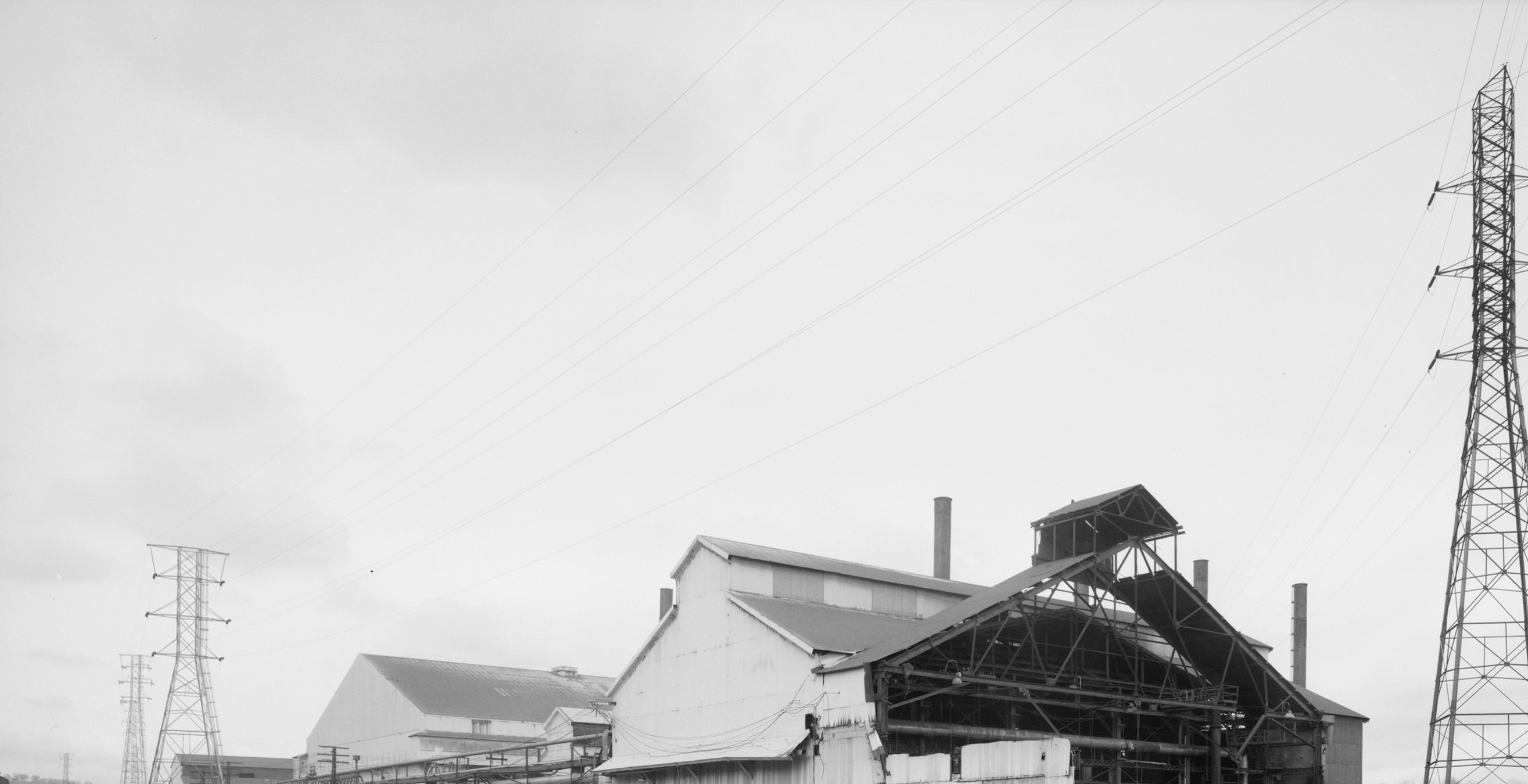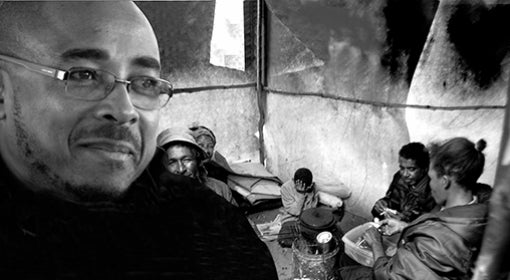This article was originally published in the February 1990 issue of Pitt Magazine.
Driving along the parkway east toward town, I say to my friend, a Pittsburgh newcomer, “Doesn’t the river look beautiful?” As soon as I say this, I realize it’s not what I mean. What I am really noticing is that I can see the river at all. No hulking, rusty, mysterious steel mill blocks my view here anymore. But then its ghost rises up and interferes, if not literally with my view of the river, certainly with my pleasure.
A few days later I am inside the National Works in McKeesport, Pa.—an existing but abandoned plant. And for as much as I could see the other mill—the one that was no longer there—I find now that it is difficult to see this one that surrounds me.
What is easy to see is the incongruous. Burdock and weed trees insist their way up through scrap piles and vine themselves around and through broken windows—signs of life like green flags against the rusty bleakness. It’s easy to see the silence of the blowing-house and the pipe mill. It’s easy to notice the cemetery-like calm in the huge, deserted pipe-ends.
But it’s much more difficult to see the truth of a steel mill. Walking onto an abandoned site for the first time is a little like going to a family reunion: Everything presses you to be seen at once. There is commotion in this industrial landscape, born of the scramble to accommodate a wildly surging demand for steel.
Amidst the ambition of a mill like this, your vision is usually organized by a particular relationship to the mill. By being the one to tap the blast furnace, for instance, or weld the pipe after it’s been shaped by the “O”-ing press. Or even, now, sadly, to appraise the mill’s value as scrap metal. But if you’re one of the uninitiated, the one who has not seen molten iron being poured or felt the heat as steel pipe is quenched, you have to wait for vision to come to you. You have to watch at the edges and wait for more and more of the center to become distinguishable. You have to wait to learn to see.
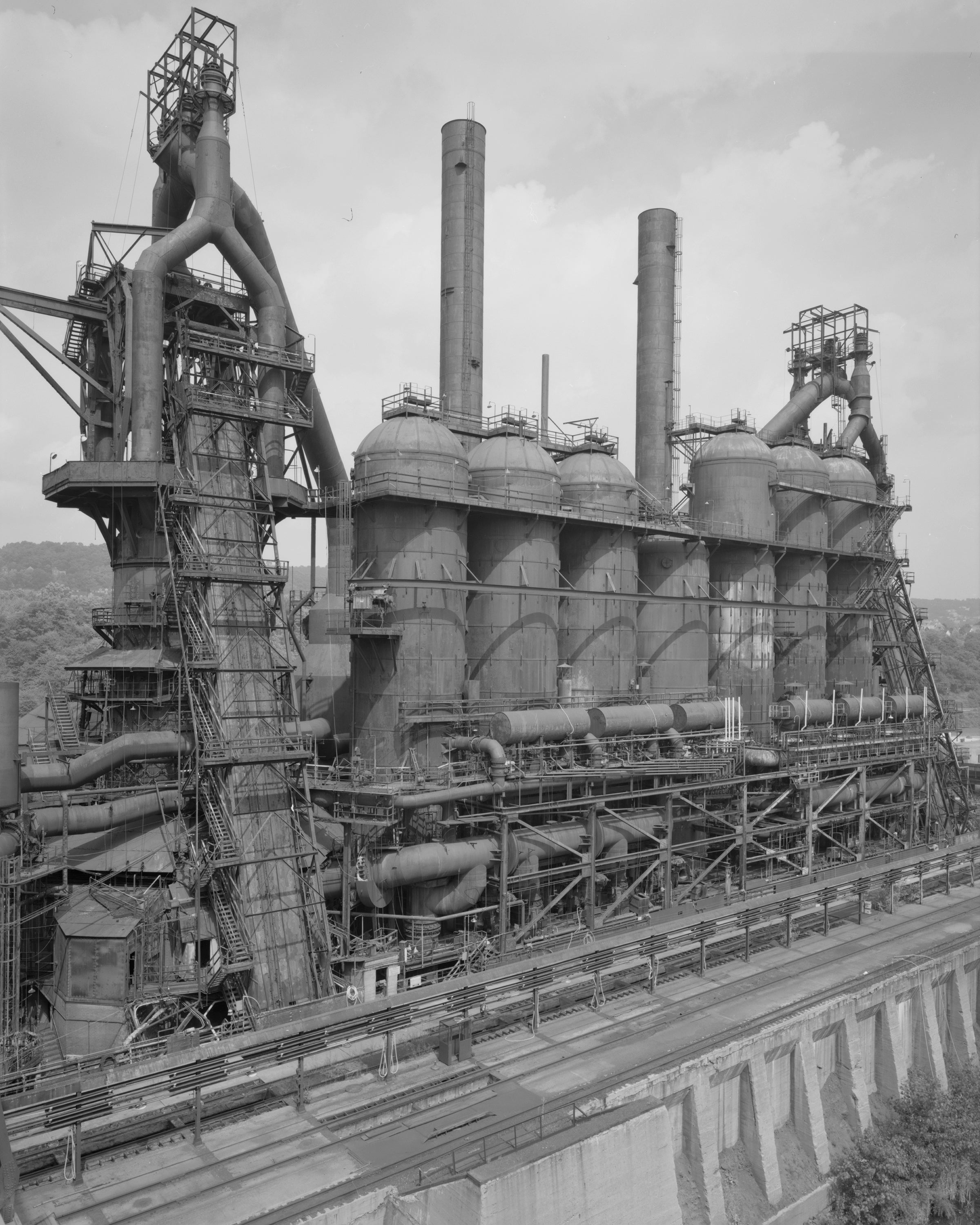 It’s dark and silent as moonless midnight down here. There is no light—only black and not-quite-so-black. Historians Gerry Kuncio and Mike Workman are in a basement that lies underneath a walking-beam furnace in McKeesport’s Quench and Temper Plant #2. When the mill was still operating, the furnace ran at 1,650 degrees Fahrenheit. On a cement beam near the foot of the stairs is someone’s faded scribbling: Welcome to Rick’s place. “Hottest Spot in Pittsburgh.” Please wait to be seated. Now, even on a blazing summer day, the air beneath the furnace feels mossy and cool.
It’s dark and silent as moonless midnight down here. There is no light—only black and not-quite-so-black. Historians Gerry Kuncio and Mike Workman are in a basement that lies underneath a walking-beam furnace in McKeesport’s Quench and Temper Plant #2. When the mill was still operating, the furnace ran at 1,650 degrees Fahrenheit. On a cement beam near the foot of the stairs is someone’s faded scribbling: Welcome to Rick’s place. “Hottest Spot in Pittsburgh.” Please wait to be seated. Now, even on a blazing summer day, the air beneath the furnace feels mossy and cool.
Kuncio carries a flashlight, Workman a clipboard and yellow tablet. The darkness creates its own set of problems as they try to figure out, from below, how the walking-beam furnace worked. The mechanical system that creates the walking-beam effect—steel beams two feet wide and girders that run the length of the room, about 30 feet—is here. But it can only be seen in a patch of flashlight at a time.
The historians do know what happened up above. They know that this furnace was used to harden steel already formed into oil pipe casings, some almost two feet in diameter. They know that pipe inched through the furnace, gradually heating in the first step toward making steel very hard but flexible. Inside the oven, curved fittings that look like perfect waves lifted and turned each pipe. But how did the “walking” beams and girders here in the basement, as substantial as bridge buttresses, create not only the progression but also the rotation in the oven above?
Kuncio and Workman walk in the narrow space between the equipment and the wall and locate two motors that run the system. Their feet crunch on scale—the gritty stuff that forms on the outside of hot steel—piled in baby dunes against the wall. Stopping at the first motor, Kuncio takes the rag that is always trailing out of his back pocket and rubs at the layers of accumulated grease on the name plate. The light he shines on the name plate reflects, illuminating Kuncio’s profile as he reads off information—the manufacturer, horsepower, voltage, RPM—to Workman, who writes it down, despite the fact that he is out of the range of the flashlight.
Each of the motors is different. This fact fits with another they already know—that the walking-beam system had up-and-down as well as sideways motion. They set about their task of unraveling, and then describing, how the motion took place. They follow the flow of power from the motor to the distribution point, a strategy that often reveals the specifics of a process. They climb onto the girders, trying to see the beams at closer range. They toss theories at each other: The stationary beams are only there for support; the stationary beams compensate for the jostle of the wheel belt; the stationary beams aren’t stationary, but raise the entire series of horizontal girders. This last theory they return to several times, each time mulling it over and finally shaking their heads: It couldn’t be.
“Big old engineering marvel, wasn’t it?” says Kuncio, flashing his light up and down one of the beams. “I want to shake the hand of the man who designed it.” He would probably like to ask that man some questions about it, too.
Kuncio and Workman are part of a federally funded team of historians and architects headed by Pitt Department of History doctoral candidate Joel Sabadasz. The National Park Service’s Historic America Engineering Record (HAER) program was established in 1969 to record the history of industrial and engineering development in the United States. For this project, it’s taken on the colossal task of documenting the history of three abandoned Mon Valley mills—the National-Duquesne Works at Duquesne and McKeesport and the Homestead Works.
“Industrial archaeology is the idea that you can look at the remnants of equipment and structures and re-create what actually was there,” Sabadasz says. “To a great degree, that’s the kind of work we’re doing. We are looking at processes or equipment, some of which has been ripped out, some of which is still there. From the remains we have to try to figure out what happened, how it looked. It’s analogous to going into the ruins of a second-century-BC Greek city and reconstructing what that city was about by looking at the physical evidence.”
“It’s right in front of your eyes,” adds Mark Brown, a PhD candidate whose architectural history work at Pitt is on steel-mill buildings. “But you still have to unearth it.”
Sabadasz points to an intimidatingly thick book on his desk. The team refers to it as “the bible”: “The Making, Shaping, and Treating of Steel”. “Every 10 years, U.S. Steel put out a new edition,” he says. “But it’s for engineers. What we’re trying to do is demystify the whole thing, bring it down to layman’s terms. Engineers are technical people focused on what is happening today. We bring skills they don’t have.”
“It’s not site specific,” adds Workman. “It deals with steel-making in a general way. We’re more oriented to the external history of technology, the social, economic, and cultural context of technology. For instance, I’m doing newspaper research on the early period of the industry. My question is how the emergence of an iron-workers union affected technology. The “Making, Shaping, and Treating” book isn’t interested in that issue.”
It is early morning in Homestead, Pa., the beginning of a working day. Sabadasz is surrounded by the clutter of a busy office. The hardhats that team members wear into the mills are lined up on the top of a bookshelf. Near the back door, on a piece of torn cardboard, sit the team’s inevitably grimy, steel-toed boots.
Across from Sabadasz’ desk, two historians consult a map, discussing the buildings they plan to inventory that day. Another historian tests a new respirator mask to screen out hazards such as PCBs, asbestos, and “moon dust” from abandoned coke-gas pipes. Walls, and parts of the floor here and there as well, are covered with photographs of steel-making equipment, historical maps, and blueprints.
Four architects work at drafting tables rendering elevations, details, and cross-sectional drawings of the Homestead Works’ 1903 12,000-ton forging press and the building housing it. Between 1892 and 1903, the building grew four-fold to accommodate the rapid increase in demand, and then stayed fundamentally the same for the next 80 years.
The architects’ field work has sometimes taken a back seat to the ongoing demolition of the Homestead Mill by its new owners, the Park Corp., a development firm: Some days the wrecking ball is simply too near the mill’s Press Shop #1. With several bays of the press shop already dismantled, the architects take what measurements they can. Field work at the mill is supplemented by old photographs and blueprints. “It’s a real detective story,” an architect says. “I came to work yesterday and noticed half of our building was gone.”
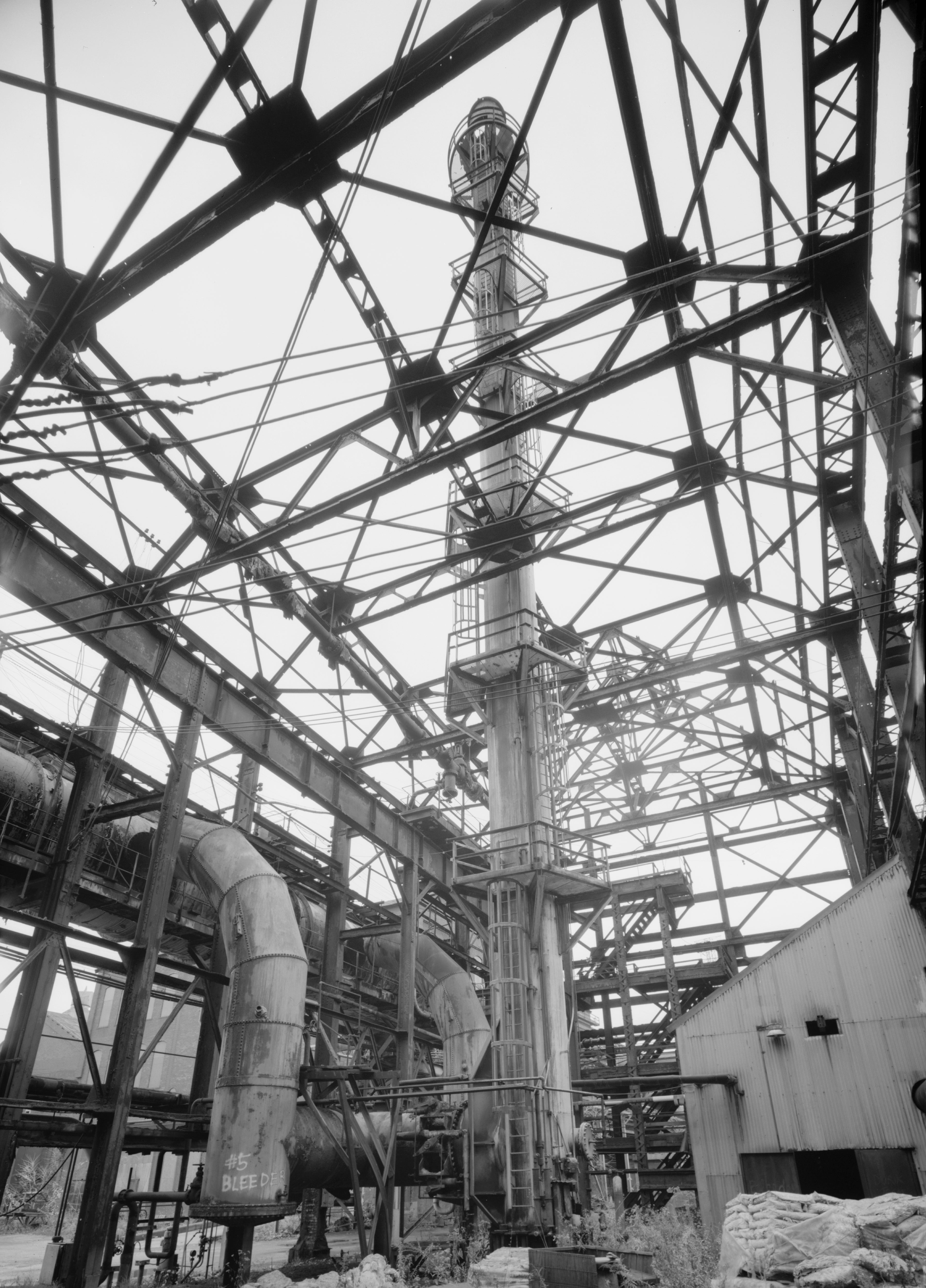 Hoist House #1, Duquesne. To get to the top, we have climbed over three sets of rusty bars, one at each flight of steps, designed to keep intruders out. The daylight here is dim, diffuse. Sabadasz takes out his flashlight and shines it on an induction motor. The nameplate has been cleaned off, a sign he has been here before.
Hoist House #1, Duquesne. To get to the top, we have climbed over three sets of rusty bars, one at each flight of steps, designed to keep intruders out. The daylight here is dim, diffuse. Sabadasz takes out his flashlight and shines it on an induction motor. The nameplate has been cleaned off, a sign he has been here before.
He wants to re-examine the moto-generator set—a motor running on A.C. current from the main power line, which starts up the D.C. power of the generator, which then, because direct current better controls varying speeds, works the skip cars on the hoist. “I looked at the other hoist houses,” he says, “and started realizing I got it wrong the first time around.”
It seems amazing he can get it right at all. Sabadasz, with a dissertation project concerning labor relations in the steel industry in the 1930s, was no newcomer to the steel industry. He spent his first two months on the project doing exhaustive reading on steel-making processes. But even with the insight that his research and background provided him, he was still not prepared for his reaction when he first set foot on the grounds. “It looked like a big black hole,” Sabadasz remembers. “I thought, How am I going to figure this out? It just looked crazy, it’s so complicated.”
Figuring things out, Sabadasz has learned, necessarily interweaves field work with library research (newspaper and journal articles from the period of the machine or process being studied) and interviews with former workers, supervisors, and managers. He has also learned some shortcuts.
“It was a few weeks before I realized the importance of investigating what was left behind in the offices,” Sabadasz says. Duquesne, Homestead, and McKeesport were known as “integrated mills”: production moved from raw materials through finished product. (“Most in this area were completely self-sufficient,” Workman once said. “Like medieval manors.”) Each process—blast furnace, boiler house, pipe mill, and so on—had its own office. “The first time I go into a part of the plant I find where the office was and spend a little bit of time going through all the manuals and books in there to see if there is something that explains the whole system,” Sabadasz says. “Usually there is. Then later when I talk to a source, I’m better informed and as a consequence, the interview can be more productive.”
Later, as we limbo under the barriers to the hoist house steps and return to ground level, Sabadasz adds, “This job is like a dream come true. I worked as an industrial pipe designer for 10 years. Then I became a historian. I looked at my life in two parts. This brings them both together.”
We move along to the more modern Hoist House #4. Sabadasz points out the skips—ore carriers that look like a hybrid of an incline car and a bucket. Skips worked in pairs, a system of balance and counter-balance, to carry the raw material—coke, iron, or limestone—to the top of the blast furnace. When they were not being run, one skip was left at the top, the other at the bottom. Here both skips meet on the cable halfway up. “These guys did a little trick when they shut the blast furnace down,” says Sabadasz. “They left the skips halfway. They’ve been like that for the last 10 years. One day, the ropes are going to break and they’ll come crashing down.” He laughs.
“Probably not today.”
One our way to visit 1896 blast furnaces, we cut back to Stock House #3. Iron-ore pellets make the footing treacherous—like walking on hundreds of small, irregularly shaped marbles. Sabadasz points to a coke screen, which can vibrate to separate large chunks of coke from “coke breeze,” the small pieces. I stare down into it. It is dark. It looks like an endless chute. It looks. Empty. Sabadasz explains how the comb in the center acted as a restraining gate to hold coke back when it was not being charged into the hoist bucket. But I don’t see a comb and I tell him so. Three times. After he’s tried to show me for the fourth time, I fudge it. I’m embarrassed. And frustrated. I want to see. I’ve tried to see. Then, just when I’ve convinced myself that he’s not pointing to the right spot, I being to see a pattern in the blackness. I see it: the comb.
It even looks like a comb.
With the electricity shut off, the daylight that wiggles into the mills through high windows and small openings in the ventilated roof is dramatic. It spotlights dust in the air, a gritty circle of floor, or the valves on a machine, without preference or logic. We are in Homestead’s stainless-steel plate finishing plant. In HAER lingo, this is Mark Brown’s plant. (Sabadasz leads the HAER field team at Duquesne, Workman at McKeesport.)
“Everything in a steel mill is monumental and intoxicating in size,” Brown had said earlier. “You don’t measure anything in pounds.”
The scene bears out his statement: The roller-lever, a machine that works the bumps out of a stainless-steel plate by snaking it over and under rollers, runs the length of a basketball court. It’s as wide as one-and-a-half lanes of highway. Brown and Workman—looking, in comparison, the size of “Honey, I Shrunk the Kids”—climb onto it, progressing as though they’re in a log-rolling contest.
This building, constructed in 1969, is one of the more modern ones. The pattern of its activity is more cleanly defined: The trolley runs on a perpendicular line; the bridge, horizontal. But the darkness makes it seem dreamy and insular, a tucked-in kind of place.
(“It’s kind of ghostly,” said Workman one day, about touring abandoned mills. “You almost feel like you’ve come in after a holocaust. You’re the only one living after a tremendous change. It’s almost like you’re supernatural because you’re survived.”)
HAER photographer Maty Stupich has set up his large-format, box camera on the other side of the rotary shear, which once cut stainless-steel plates to an accuracy of 1/32 of an inch. He bathes the area with light for long stretches of time. These photographs will take 12 minutes to record the image on film. For some he’s waited as long as an hour.
The shears are an example of what Workman calls “ponderous machinery.” He explains, “I think of the mills in a deeper way than just function. I begin to think of them as being human places with messages of people, messages of culture, messages of attitudes. Everything shaped, formed, and used by humankind takes on their attitudes and values. You can look at those machines and see the mind of the person who designed them. You can also see how they affected the people who operated them.
“I get appreciation from all the work, all the discoveries, all the many geniuses that have gone into making these machines. Most of them are amazingly complex. It makes you marvel at the human mind.”
Outside, not far away, is the clamor of demolition, the torching of metal, the yellow hazard tape. What is happening now at Homestead will soon reach Duquesne and McKeesport. Buildings that have no potential for use other than steel-making are being broken down into scrap metal. Others will be refurbished for industrial and commercial purposes. A few will be saved for their historic value.
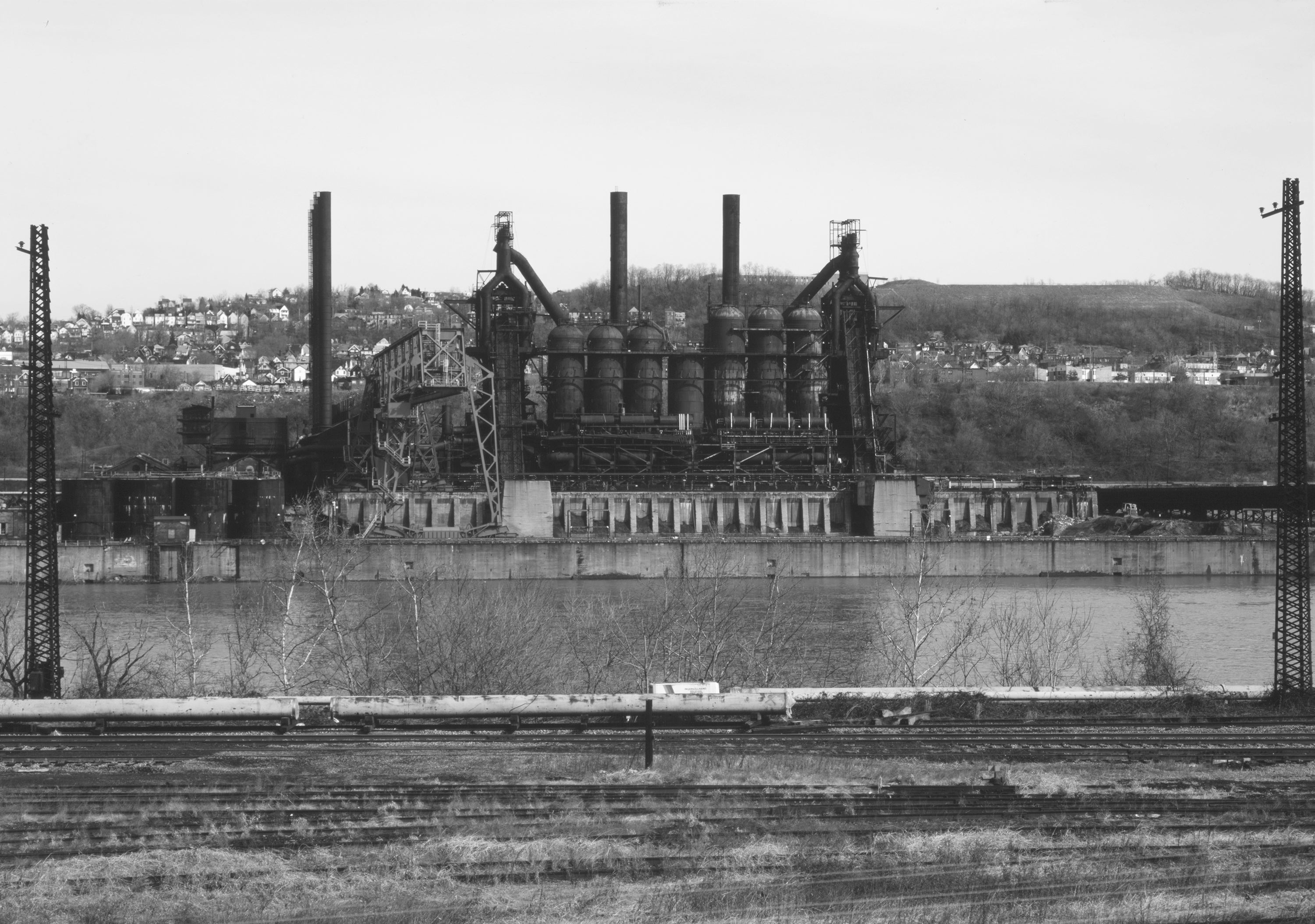 A toothbrush lies outside of its purple plastic travel container in locker 70762 in McKeesport’s pipe mill. The toothpaste is on the ground. “Joe,” over in 70331, left behind his safety goggles.
A toothbrush lies outside of its purple plastic travel container in locker 70762 in McKeesport’s pipe mill. The toothpaste is on the ground. “Joe,” over in 70331, left behind his safety goggles.
Additional graffiti: Where’s the fire? and Last Load 6/8/87 AM. Cigar boxes and coffee cans hold odds and ends as though this were someone’s garage. At the operator’s pulpit for the OD (outside diameter) weld, the swivel chair is turned toward the doorway as though the operator just ran out to grab a cup of coffee. Be right back. A sign on the door: The threat is real from foreign steel.
At Carnegie Music Hall in Homestead, Sabadasz, Workman, and Brown present a slide show and overview of their work. During the question and answer period, a short, rounded, well-dressed man in the first row rises. He doesn’t have a question. Rather he is there to give witness. He says that he turned down an opportunity to build blast furnaces in Formosa and that he’s proud of it. “I worked in steel since 1946,” he announces. “I don’t want to blame labor, or management, or the stockholders.”
This man doesn’t have the answer to what went wrong, what drove steel out of the Mon Valley. He’s not looking for one. What he’ll settle for is what he can understand—what went on in the mills, how they worked. And a sense of community with the others for whom the valley’s steel mills have been meaningful.
If steel has shaped the lives of the people here for generations, there’s a sense in which letting go of the mills is breaking that link with parents, grandparents, great-grandparents. It becomes more difficult to answer the question, “Who are we?” That answer might be one that can be arrived at only by looking back, perhaps even generations later. The history that the HAER team compiles can offer some comfort and a certain knowledge to the people of these communities. But the map that history offers is to people who aren’t here yet.
In the meantime, you have to learn to wait to see.
Cover image: 48” plate mill at the U.S. Steel Homestead Works along the Monongahela River

